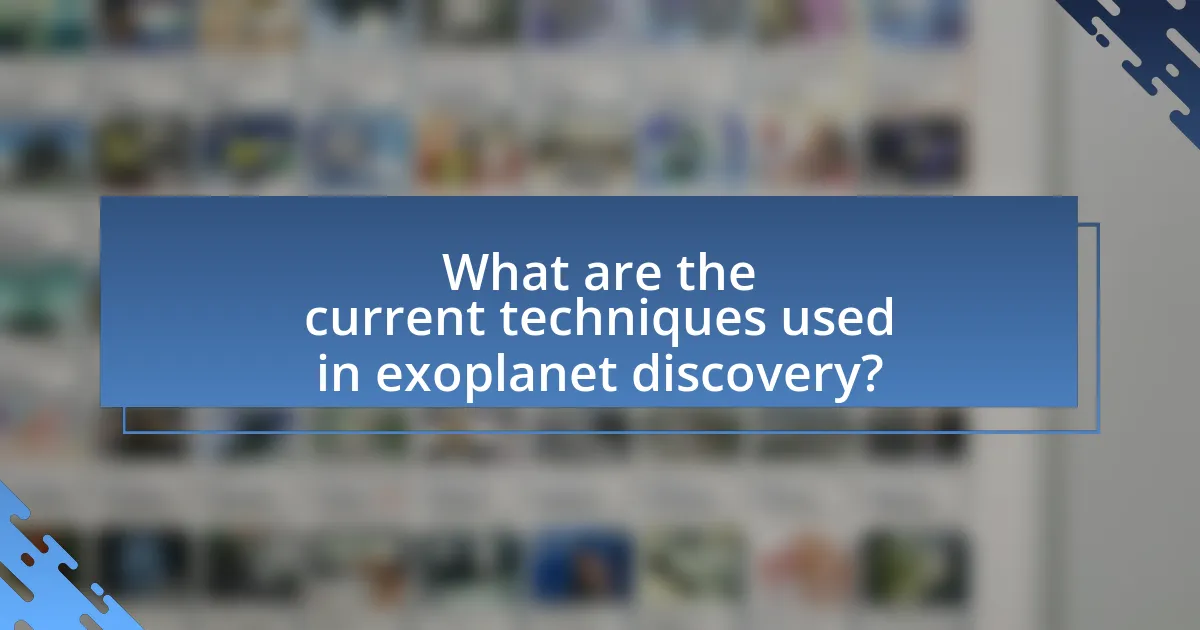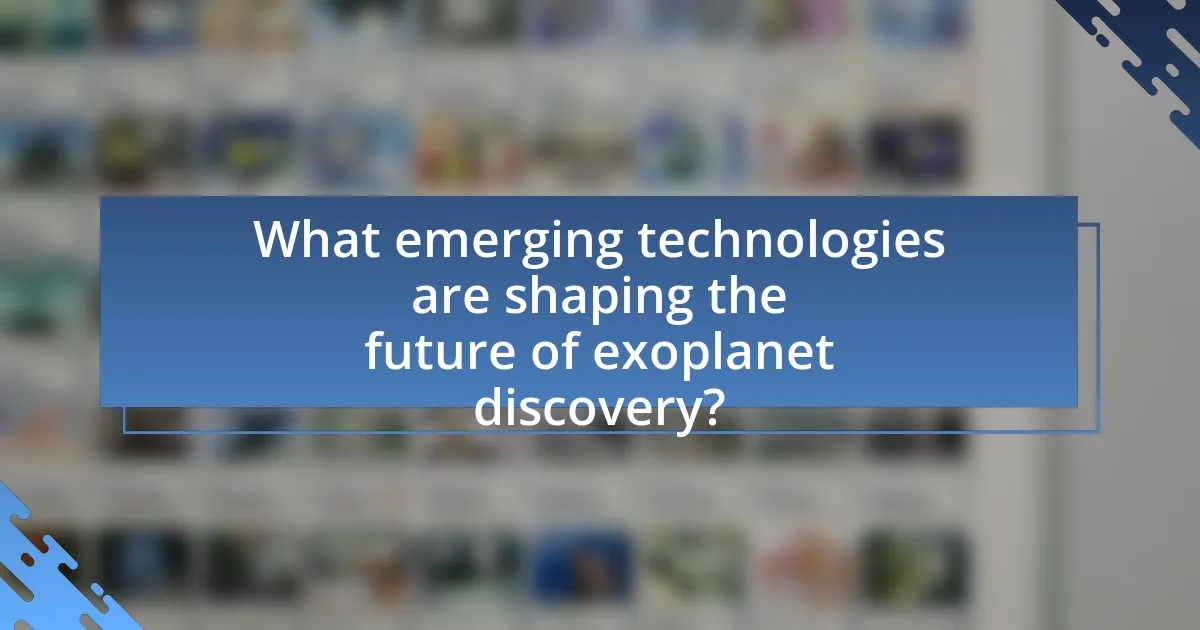The article focuses on the future of exoplanet discovery, highlighting current techniques such as the transit method, radial velocity method, direct imaging, and gravitational microlensing. It delves into the mechanics of transit photometry and radial velocity, discussing their advantages and limitations, as well as the role of direct imaging in capturing exoplanet characteristics. Emerging technologies, including advanced telescopes and artificial intelligence, are examined for their potential to enhance detection and analysis of exoplanets. The implications of future discoveries for science and society, particularly in understanding planetary formation and the search for extraterrestrial life, are also addressed.

What are the current techniques used in exoplanet discovery?
The current techniques used in exoplanet discovery include the transit method, radial velocity method, direct imaging, and gravitational microlensing. The transit method detects exoplanets by observing the dimming of a star’s light as a planet passes in front of it, which has been successfully employed by missions like Kepler and TESS. The radial velocity method measures variations in a star’s spectrum due to the gravitational pull of an orbiting planet, providing insights into the planet’s mass and orbit. Direct imaging captures images of exoplanets by blocking out the star’s light, allowing for the study of their atmospheres and compositions. Gravitational microlensing occurs when a massive object, like a star, magnifies the light of a more distant star, revealing the presence of planets around the foreground star. These techniques have collectively led to the discovery of thousands of exoplanets, significantly advancing our understanding of planetary systems beyond our own.
How do transit photometry methods work in detecting exoplanets?
Transit photometry methods detect exoplanets by measuring the dimming of a star’s light as a planet passes in front of it. This technique relies on the principle that when a planet transits, it blocks a fraction of the star’s light, resulting in a temporary decrease in brightness. The amount of light blocked is proportional to the size of the planet relative to the star, allowing astronomers to infer the planet’s size and orbital period. For instance, the Kepler Space Telescope utilized this method to identify thousands of exoplanets by continuously monitoring the brightness of over 150,000 stars, detecting dips in brightness as small as 0.008%. This high sensitivity enables the identification of Earth-sized planets in the habitable zones of their stars.
What are the advantages of using transit photometry?
Transit photometry offers several advantages for exoplanet discovery, primarily its ability to detect small changes in brightness caused by a planet passing in front of its host star. This method allows astronomers to identify exoplanets with high precision, as it can detect even Earth-sized planets in the habitable zone of stars. Additionally, transit photometry enables the determination of a planet’s size and orbital period, which are crucial for understanding its potential habitability. The Kepler Space Telescope, for instance, utilized transit photometry to discover over 2,300 confirmed exoplanets, demonstrating its effectiveness and reliability in the field of astronomy.
What limitations does transit photometry face?
Transit photometry faces limitations such as the requirement for precise measurements of light curves, which can be affected by stellar variability and noise. Stellar variability can introduce false positives in detecting exoplanets, as changes in brightness may be misinterpreted as transits. Additionally, transit photometry is biased towards detecting larger planets close to their host stars, limiting the discovery of smaller, potentially habitable exoplanets. The method also relies on the alignment of the planet’s orbit with the observer’s line of sight, making many planets undetectable. These factors collectively constrain the effectiveness and scope of transit photometry in exoplanet discovery.
What role does radial velocity play in exoplanet detection?
Radial velocity is a crucial method for detecting exoplanets, as it measures the changes in a star’s velocity due to the gravitational influence of an orbiting planet. This technique relies on the Doppler effect, where the light from a star shifts toward the red or blue end of the spectrum as the star moves away from or toward Earth, respectively. By observing these shifts, astronomers can infer the presence of a planet, its mass, and its orbital characteristics. For instance, the discovery of the first exoplanet around a sun-like star, 51 Pegasi b, in 1995 was made using radial velocity measurements, demonstrating its effectiveness in identifying exoplanets.
How is the radial velocity method implemented?
The radial velocity method is implemented by measuring the Doppler shifts in the spectrum of a star caused by the gravitational influence of an orbiting planet. This technique involves precise spectroscopic observations to detect changes in the star’s light spectrum, which indicate the star’s motion towards or away from Earth due to the gravitational pull of the planet. The method relies on the principle that as a planet orbits, it exerts a gravitational force on its host star, causing the star to wobble slightly. This wobble results in periodic shifts in the star’s spectral lines, which can be quantified to determine the planet’s mass and orbital characteristics. The effectiveness of this method has been demonstrated through the discovery of numerous exoplanets, with over 4,000 confirmed exoplanets detected using radial velocity techniques as of 2023.
What are the challenges associated with the radial velocity technique?
The challenges associated with the radial velocity technique include its sensitivity to noise, the need for high-precision measurements, and the difficulty in distinguishing between signals from multiple celestial bodies. Radial velocity relies on detecting minute changes in a star’s spectrum due to the gravitational influence of orbiting planets, which can be obscured by stellar activity, instrumental errors, and other astrophysical phenomena. For instance, variations in a star’s brightness or magnetic activity can mimic or mask the signals produced by exoplanets, complicating the interpretation of data. Additionally, the technique is limited in detecting smaller planets, as the induced velocity changes are often below the detection threshold for less massive bodies.
How does direct imaging contribute to exoplanet discovery?
Direct imaging significantly contributes to exoplanet discovery by allowing astronomers to capture images of planets directly, rather than inferring their presence through indirect methods. This technique enables the observation of exoplanets in their own light, providing crucial data about their atmospheres, compositions, and potential habitability. For instance, the direct imaging of exoplanets like HR 8799 b, c, d, and e has revealed information about their atmospheric characteristics and chemical compositions, which are essential for understanding their formation and evolution.
What technologies are used in direct imaging?
Direct imaging employs several key technologies, including coronagraphy, starshades, and adaptive optics. Coronagraphy utilizes a mask to block starlight, allowing for the observation of nearby exoplanets. Starshades are deployed in space to create an artificial eclipse, significantly reducing starlight interference. Adaptive optics corrects for atmospheric distortions in real-time, enhancing image clarity. These technologies collectively improve the ability to detect and analyze exoplanets by minimizing the overwhelming brightness of their host stars.
What are the limitations of direct imaging in exoplanet research?
Direct imaging in exoplanet research faces significant limitations, primarily due to the challenges of distinguishing the faint light of exoplanets from the overwhelming brightness of their host stars. This difficulty arises because exoplanets are often much dimmer than their stars, making it hard to capture clear images. Additionally, atmospheric interference and instrumental noise can further obscure the signals from exoplanets, complicating the detection process. For instance, current telescopes can only directly image a small fraction of exoplanets, typically those that are large and far from their stars, limiting the scope of potential discoveries. Furthermore, the resolution required to resolve exoplanets from their stars necessitates advanced technology and significant observational time, which are not always available. These factors collectively hinder the effectiveness of direct imaging as a method for comprehensive exoplanet exploration.

What emerging technologies are shaping the future of exoplanet discovery?
Emerging technologies shaping the future of exoplanet discovery include advanced telescopes, machine learning algorithms, and space-based observatories. Advanced telescopes, such as the James Webb Space Telescope, enhance our ability to detect and analyze exoplanet atmospheres through improved infrared imaging. Machine learning algorithms process vast datasets from observations, identifying patterns that indicate the presence of exoplanets more efficiently than traditional methods. Space-based observatories, like the upcoming Roman Space Telescope, will provide unprecedented survey capabilities, allowing for the discovery of a greater number of exoplanets across diverse environments. These technologies collectively enhance our understanding of exoplanets and their potential habitability.
How will space telescopes enhance our ability to discover exoplanets?
Space telescopes will enhance our ability to discover exoplanets by providing unobstructed views of distant star systems, allowing for more precise measurements of light and planetary transits. These telescopes, such as the James Webb Space Telescope, utilize advanced instruments to detect the faint light from exoplanets and analyze their atmospheres. For instance, the transit method, which measures the dimming of a star’s light as a planet passes in front of it, becomes significantly more effective in space due to the absence of atmospheric interference. This capability has already led to the identification of thousands of exoplanets, demonstrating the effectiveness of space-based observations in expanding our understanding of planetary systems beyond our own.
What are the key features of upcoming space telescopes?
Upcoming space telescopes are designed with advanced features that enhance their observational capabilities, including larger apertures, improved sensitivity, and multi-wavelength observation. For instance, the James Webb Space Telescope (JWST) boasts a 6.5-meter primary mirror, significantly larger than its predecessors, allowing it to capture more light and observe fainter objects. Additionally, the Roman Space Telescope will utilize a wide-field camera to survey large areas of the sky, enabling the discovery of numerous exoplanets through gravitational microlensing. These telescopes also incorporate cutting-edge technology such as adaptive optics and spectrographs, which improve image clarity and allow for detailed analysis of exoplanet atmospheres. The combination of these features positions upcoming space telescopes to revolutionize our understanding of the universe and facilitate the discovery of new exoplanets.
How do these features improve exoplanet detection?
Advanced features such as high-resolution spectroscopy and improved photometric precision significantly enhance exoplanet detection. High-resolution spectroscopy allows astronomers to analyze the chemical composition and atmospheric conditions of exoplanets, enabling the identification of biosignatures. Improved photometric precision reduces noise in light curves, increasing the accuracy of transit measurements and allowing for the detection of smaller planets. For instance, the Kepler Space Telescope’s photometric capabilities led to the discovery of over 2,300 confirmed exoplanets, demonstrating the effectiveness of these features in expanding our understanding of planetary systems.
What advancements in spectroscopy are influencing exoplanet studies?
Recent advancements in spectroscopy, particularly high-resolution and multi-wavelength techniques, are significantly influencing exoplanet studies. These advancements enable astronomers to analyze the atmospheric composition of exoplanets with greater precision, allowing for the detection of key molecules such as water vapor, carbon dioxide, and methane. For instance, the use of transmission spectroscopy during transits has improved the ability to identify atmospheric signatures, as demonstrated by the Hubble Space Telescope’s observations of exoplanet atmospheres, which have revealed the presence of water and other compounds. Additionally, the development of ground-based observatories equipped with adaptive optics and spectrographs enhances the capability to study exoplanets in detail, providing insights into their chemical and physical properties.
How does spectroscopy help in analyzing exoplanet atmospheres?
Spectroscopy aids in analyzing exoplanet atmospheres by measuring the light spectrum emitted or absorbed by the planet’s atmosphere. This technique allows scientists to identify the chemical composition, temperature, and pressure of the atmosphere based on the specific wavelengths of light that are absorbed or emitted by different molecules. For instance, the detection of water vapor, carbon dioxide, and methane in the atmospheres of exoplanets has been achieved through spectroscopy, providing insights into potential habitability. The Hubble Space Telescope and the James Webb Space Telescope utilize spectroscopy to gather data on exoplanet atmospheres, confirming the presence of these molecules through their unique spectral signatures.
What are the future prospects for spectroscopy in exoplanet research?
The future prospects for spectroscopy in exoplanet research are highly promising, as advancements in technology will enhance the ability to detect and analyze the atmospheres of distant planets. Upcoming space missions, such as the James Webb Space Telescope, are equipped with advanced spectroscopic instruments that can provide detailed information about the chemical composition of exoplanet atmospheres. These instruments will enable scientists to identify biomarkers and assess the habitability of exoplanets, significantly advancing our understanding of potential life beyond Earth. Additionally, improvements in ground-based telescopes and adaptive optics will further refine spectroscopic measurements, allowing for more precise data collection.
How is artificial intelligence being utilized in exoplanet discovery?
Artificial intelligence is utilized in exoplanet discovery primarily through data analysis and pattern recognition in astronomical datasets. Machine learning algorithms process vast amounts of data from telescopes, such as the Kepler Space Telescope, to identify potential exoplanet candidates by detecting periodic dips in star brightness, which indicate transits. For instance, a study published in 2020 by researchers at the Massachusetts Institute of Technology demonstrated that AI could improve the identification of exoplanets by up to 90% compared to traditional methods. This capability allows astronomers to efficiently sift through millions of light curves, significantly accelerating the discovery process and enhancing the accuracy of exoplanet detection.
What specific AI techniques are being applied?
Specific AI techniques being applied in exoplanet discovery include machine learning algorithms, neural networks, and data mining methods. Machine learning algorithms analyze large datasets from telescopes to identify patterns indicative of exoplanets, while neural networks enhance the accuracy of classification tasks by learning from labeled data. Data mining methods extract relevant information from vast astronomical databases, enabling researchers to discover new exoplanets more efficiently. These techniques have been validated through successful applications in projects like NASA’s Kepler mission, which utilized machine learning to detect thousands of exoplanets from light curve data.
What benefits does AI bring to the analysis of exoplanet data?
AI significantly enhances the analysis of exoplanet data by improving the accuracy and efficiency of data processing. Machine learning algorithms can analyze vast datasets from telescopes, identifying patterns and anomalies that human researchers might overlook. For instance, AI techniques like neural networks have been employed to detect exoplanets in light curves, achieving higher detection rates compared to traditional methods. A study published in the journal Nature Astronomy demonstrated that AI could reduce the time required for data analysis by up to 90%, allowing astronomers to focus on more complex interpretations of the findings. This capability not only accelerates the discovery process but also increases the likelihood of identifying potentially habitable exoplanets.

What are the implications of future exoplanet discoveries for science and society?
Future exoplanet discoveries will significantly advance scientific knowledge and influence societal perspectives on life beyond Earth. These discoveries can enhance our understanding of planetary formation, atmospheric conditions, and the potential for habitability, thereby informing theories in astrophysics and planetary science. For instance, the detection of Earth-like exoplanets in the habitable zone of their stars could provide critical data for evaluating the likelihood of extraterrestrial life, as evidenced by the Kepler Space Telescope’s findings of thousands of exoplanets, many of which are in habitable zones.
Moreover, the societal implications include a shift in human perspective regarding our place in the universe. As discoveries suggest the possibility of life elsewhere, public interest in space exploration and science may increase, potentially leading to greater funding and support for scientific research. This is supported by surveys indicating that a significant portion of the public is fascinated by the prospect of extraterrestrial life, which can drive educational initiatives and inspire future generations in STEM fields.
In summary, future exoplanet discoveries will not only deepen scientific understanding but also reshape societal views on life in the universe, fostering a culture of exploration and inquiry.
How might new discoveries change our understanding of the universe?
New discoveries can significantly alter our understanding of the universe by revealing previously unknown phenomena, expanding our knowledge of cosmic structures, and redefining the conditions necessary for life. For instance, the detection of exoplanets in habitable zones has led to new theories about the potential for life beyond Earth, as evidenced by the Kepler Space Telescope’s findings, which identified over 2,300 confirmed exoplanets. Additionally, advancements in technology, such as the James Webb Space Telescope, allow for deeper observations of distant galaxies and the study of their formation, which can reshape our comprehension of cosmic evolution. These discoveries not only enhance our scientific models but also challenge existing paradigms, prompting a reevaluation of fundamental concepts in astrophysics and cosmology.
What are the potential impacts on theories of planetary formation?
The potential impacts on theories of planetary formation include the need to revise existing models to account for new data from exoplanet discoveries. As telescopes and detection methods improve, such as the use of the James Webb Space Telescope, researchers are uncovering a diverse range of planetary systems that challenge traditional theories. For instance, the discovery of gas giants in close orbits around their stars contradicts the classical view that such planets form far from their host stars and migrate inward. This necessitates the development of new formation models that incorporate factors like disk dynamics and migration processes. Additionally, the detection of Earth-like planets in habitable zones raises questions about the conditions necessary for planet formation and the potential for life, further influencing theoretical frameworks in planetary science.
How could exoplanet discoveries influence astrobiology?
Exoplanet discoveries could significantly influence astrobiology by expanding the understanding of potential habitats for life beyond Earth. The identification of exoplanets within the habitable zone, where conditions may support liquid water, allows scientists to refine models of life’s potential existence and evolution in diverse environments. For instance, the Kepler Space Telescope has confirmed thousands of exoplanets, many of which exhibit Earth-like characteristics, prompting researchers to investigate their atmospheres for biosignatures. This exploration is crucial, as it provides empirical data that can validate or challenge existing theories about life’s origins and distribution in the universe.
What societal benefits could arise from advancements in exoplanet research?
Advancements in exoplanet research could lead to significant societal benefits, including enhanced scientific knowledge, technological innovation, and potential solutions to global challenges. Increased understanding of exoplanets can drive educational initiatives, inspiring future generations in STEM fields. For instance, the discovery of potentially habitable exoplanets may stimulate discussions about climate change and sustainability on Earth, encouraging the development of technologies that promote environmental stewardship. Furthermore, the techniques developed for exoplanet detection, such as improved imaging and data analysis methods, often have applications in other fields, including medicine and telecommunications, thereby fostering economic growth and job creation.
How can exoplanet discoveries inspire future generations in STEM fields?
Exoplanet discoveries can inspire future generations in STEM fields by igniting curiosity and fostering a passion for exploration and scientific inquiry. The identification of thousands of exoplanets, particularly those in habitable zones, showcases the potential for life beyond Earth, motivating students to pursue careers in astronomy, physics, and engineering. For instance, the Kepler Space Telescope’s mission, which confirmed over 2,300 exoplanets, has significantly increased interest in space science, leading to a rise in STEM enrollment in universities. This trend is supported by data from the National Science Foundation, which indicates that fields related to space exploration have seen a 30% increase in student interest since the early 2000s. Such discoveries not only provide tangible goals for research but also highlight the importance of interdisciplinary collaboration, encouraging students to engage in diverse scientific fields.
What role do exoplanets play in the search for extraterrestrial life?
Exoplanets play a crucial role in the search for extraterrestrial life by providing potential environments where life could exist beyond Earth. The discovery of exoplanets, particularly those within the habitable zone of their stars, allows scientists to identify planets that may have conditions suitable for life, such as liquid water and a stable atmosphere. For instance, the Kepler Space Telescope has identified thousands of exoplanets, many of which are Earth-sized and located in their star’s habitable zone, suggesting they could support life. This data is essential for guiding future missions and research focused on detecting biosignatures, or signs of life, on these distant worlds.
What practical steps can researchers take to enhance exoplanet discovery efforts?
Researchers can enhance exoplanet discovery efforts by utilizing advanced observational techniques and improving data analysis methods. Implementing space-based telescopes, such as the James Webb Space Telescope, allows for more precise measurements of exoplanet atmospheres and orbits. Additionally, employing machine learning algorithms can significantly increase the efficiency of data processing, enabling the identification of potential exoplanets from vast datasets. For instance, the Kepler Space Telescope’s data analysis has been augmented by machine learning, resulting in the discovery of thousands of exoplanets. Furthermore, collaboration among international research teams can pool resources and expertise, leading to more comprehensive studies and innovative approaches in exoplanet research.


